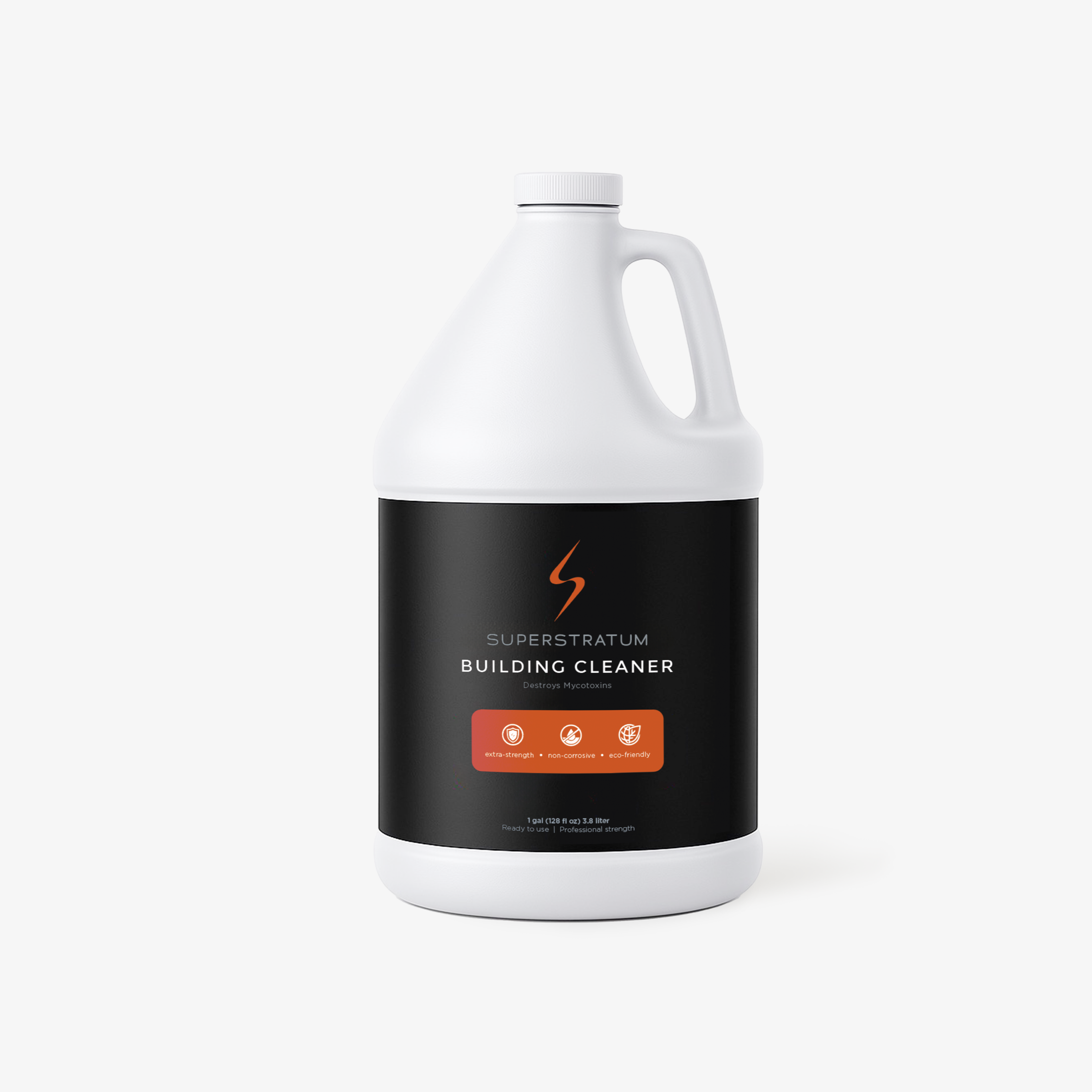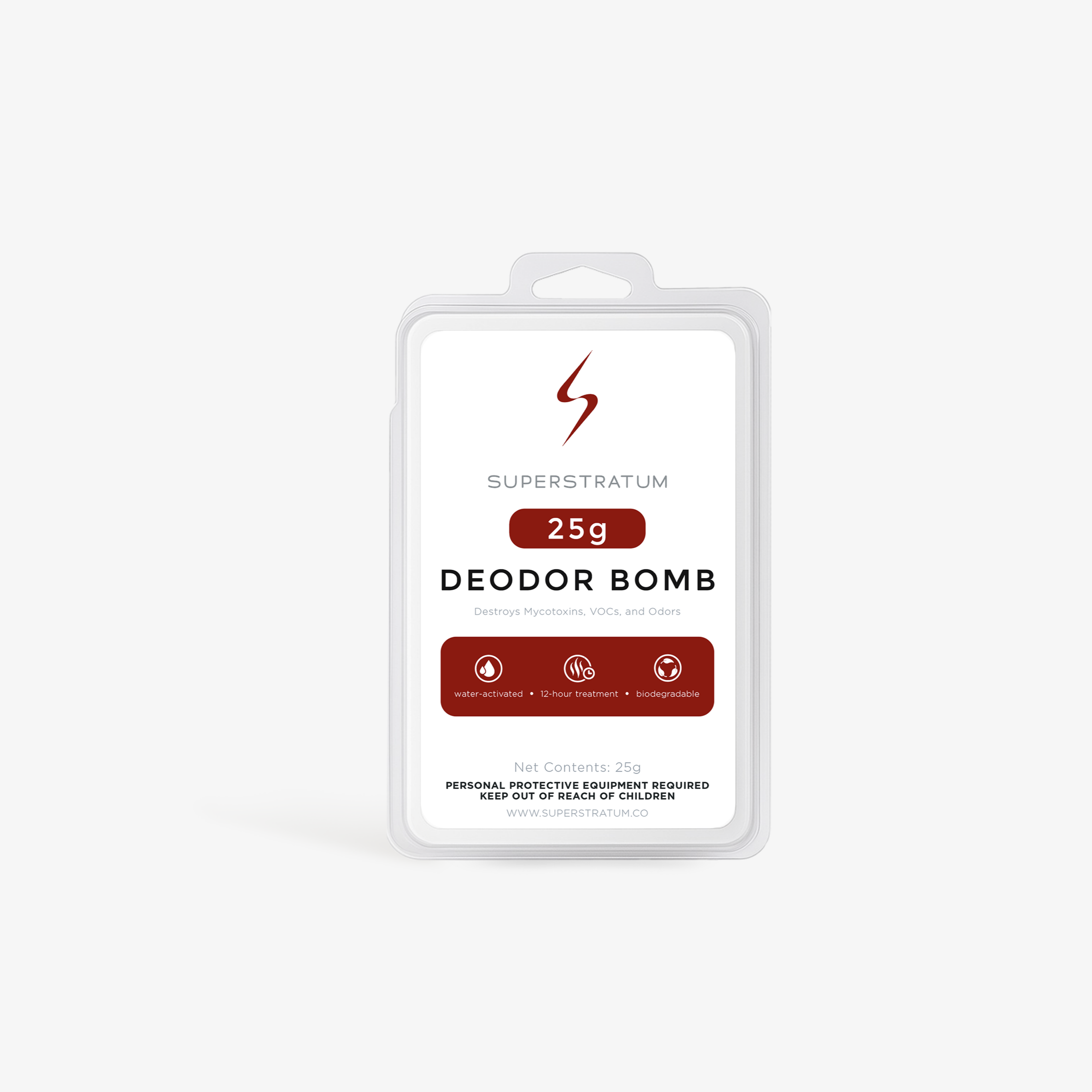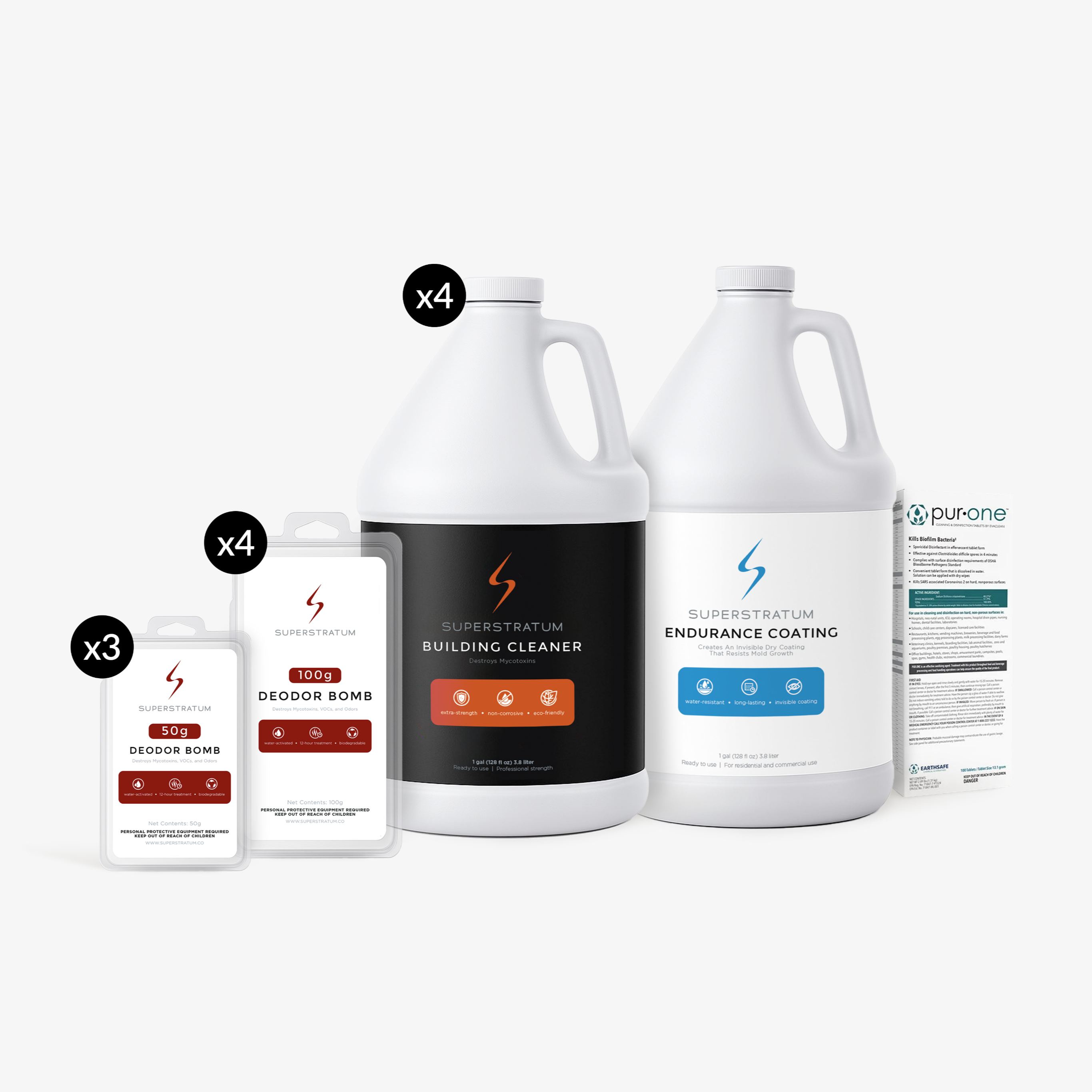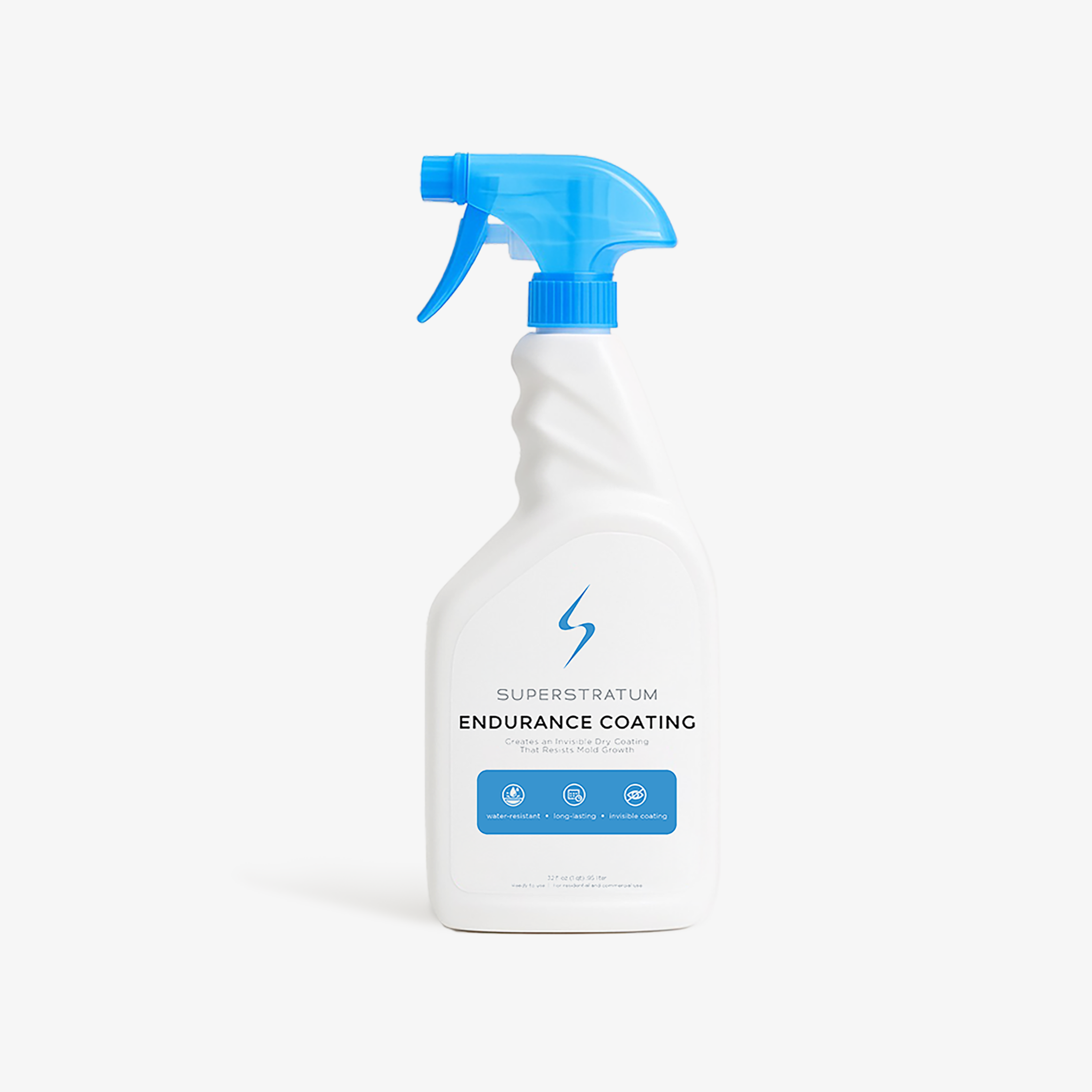
by Seth Jones
Founder & CEO || Superstratum Labs
Mold resistance is one of the toughest challenges in modern building science. Builders, architects, and environmental professionals all share a common frustration: how do we achieve mold-resistance in real-world, moisture-laden environments?
The answer, until recently, has been: you can’t.
Even seasoned mold remediation experts remain skeptical that any product can truly “resist” mold in the face of repeated wetting and drying. This skepticism isn’t misplaced. Historically, the chemistry and physics simply haven’t been there.
In this article, we’ll explore why true mold resistance has been so difficult to achieve, and introduce the first solution to crack the code: Superstratum Endurance Coating (EC). We’ll examine its chemistry, the biological mechanisms it leverages, and laboratory test results demonstrating its performance in extreme conditions.
Why Mold Resistance Has Seemed Impossible
Let’s look deeper at why past attempts to create mold-resistant coatings have failed.
The Fundamental Problem: Bioavailability of Biocides
Biocides are substances capable of killing or inhibiting microorganisms, including mold. However, there’s a fundamental paradox in coatings:
To be durable, a coating must cure into a solid film, sealing the surface beneath. Yet, once biocides are locked into this film, they’re no longer bioavailable [1].
In other words, the active agents that could stop mold growth become inaccessible because they’re physically trapped inside a hardened layer of resin or polymer.
Shortcomings of Traditional Mold-Resistant Technologies
Quaternary Ammonium Compounds (“Quats”)
Quats are among the most common antimicrobial agents used in cleaners, disinfectants, and some protective coatings. They work by disrupting microbial cell membranes. However, quats are water-soluble. Moisture can wash them away. Their antimicrobial potency degrades rapidly when exposed to oxygen, UV light, or fluctuating humidity. Once a quat dries onto a surface, it may become chemically inert and lose efficacy. In laboratory tests, even highly concentrated quats failed to prevent mold regrowth under moisture exposure [5].
Encapsulating Paints and Coatings
Mold-resistant paints often contain biocides mixed into the liquid formulation. When applied and dried, the biocides are locked within a continuous cured film. Mold spores cannot reach the biocides. The biocides cannot migrate to the surface without breaking the film.
Thus, these coatings act more as physical barriers than active antimicrobial defenses. If moisture penetrates or condenses behind the film, mold may still grow underneath and cause structural fungal issues like dry rot.
This physical “encapsulating” effect is why mold-resistant paints often fail under real-world conditions, especially in crawlspaces, joists, and structural wood.
Mold’s Survival Advantage
Mold is a highly adaptable organism. Under the right moisture conditions, spores germinate within hours. Hyphae (the threadlike filaments of mold) penetrate porous substrates like wood, drywall, and masonry. Mold colonies produce secondary metabolites called mycotoxins, which can chemically damage surrounding materials and harm human health [4].
Traditional coatings have simply not been engineered to outsmart mold’s biology.
Superstratum Endurance Coating: A New Class of Chemistry
Superstratum Endurance Coating (EC) represents a true breakthrough because it’s built around smart polymer chemistry—an entirely different approach to mold resistance.
Water-Based, Yet Water-Resistant
EC begins as a water-based liquid, making it safe and easy to apply to virtually any building material:
- Wood
- Concrete
- Masonry
- Vinyl
- Stone
- Metal
- Fabric
Once applied, it dries into an invisible, breathable film. However, unlike paints, it does not form a single continuous barrier [1].
Smart Polymer Matrix
Here’s where the technology gets innovative: The polymer system creates a microscopic speckled pattern. These speckles create a web matrix with each node encapsulating biocidal agents. Rather than forming one big solid layer, these nodes leave small gaps between them.
These gaps serve two critical functions. They preserve the substrate’s breathability. They allow biocides to migrate to the surface under wet conditions [1].
Water Activates, Not Washes Away
Conventional wisdom says that moisture destroys antimicrobial coatings but EC turns that paradigm upside down.
In dry conditions, biocides remain encapsulated, minimizing unnecessary release. When exposed to moisture, the polymer changes slightly. This change shifts the biocides to the coating’s surface. Once moisture evaporates, the polymer shifts back, protecting the remaining biocides for future use [1].
In this sense, EC is a smart polymer: water triggers its protective action rather than destroying it. And all of this is happening at an invisible level.
But what's in it? EC uses biocides commonly found in personal care products like shampoos, lotions, and baby wipes—not the industrial biocides typically used in cleaning or mold remediation products. These consumer-grade biocides are formulated for safety even with direct skin contact and are well studied in toxicology literature for their low hazard profiles at typical use levels [1].
Labs and Customers Putting Endurance Coating to the Test
Laboratory testing provides the ultimate proof. Let’s explore three key experiments.
Lab Test Case – Extreme water exposure
In a straightforward yet revealing test, two squares of Whatman filter paper were sprayed with EC. One square was subjected to continuous running water for 24 hours. Both samples were then inoculated with mold spores and incubated for 3 weeks at 82°F.
Results: Sample one showed a zone of inhibition around the coating demonstrating its extreme mold-resistance applied. 
Although sample two was exposed to continuous water for 24 hours, there was still no mold growth and the zone of inhibition remained intact.

Mold Remediator Test Case – Quat Comparison on Mold Plates
To benchmark EC’s performance against their traditional chemistry, a leading national mold remediation franchise conducted a comparison with quaternary ammonium compounds.
Procedure: Petri dishes were sprayed with either Superstratum EC, a 6% solution of quaternary ammonium salt, or a 25% solution of quaternary ammonium salt. All samples were allowed to dry. The dishes were then inoculated with mold spores [5].
Day 3 Observations: Mold growth appeared in both dishes treated with quat solutions—even at 25% concentration. The EC-treated dish showed no mold growth.
Day 15 Observations: Mold overran the dishes treated with quats. The EC dish remained completely mold-free.

Final Results After Two Months: “Two months after inoculation, Superstratum Endurance Coating Pro still showed no signs of growth.” [5]
The company's technical team co-presented these results to their national licensees in a webinar to highlight a critical point. Traditional quats cannot survive long-term moisture exposure and environmental challenges. EC’s polymer matrix preserves biocide activity, delivering reliable mold-resistance over weeks and months—not just days.
Duct Cleaning Test Case – Testing on HVAC Treated Liner
An additional independent test conducted by a leading duct cleaning company in Dubai evaluated Superstratum Endurance Coating Pro on a treated liner using ASTM D 3273-21, the standard test for resistance to mold growth on coatings in environmental chambers [6].
Procedure:
Two samples were tested:
-
- A liner treated with Superstratum Endurance Coating Pro
- An untreated liner as a control
Samples were placed in a controlled environmental chamber and exposed to mold spores of:
-
-
-
- Aspergillus niger
- Aureobasidium pullulans
- Penicillium species
-
-
The exposure lasted 4 weeks under elevated humidity and temperature, with weekly visual inspections.
Results:
The untreated liner deteriorated steadily, dropping to a rating of “6” by week four, indicating 31–40% mold coverage [6].


The treated liner consistently scored “10” on the ASTM scale, indicating zero visible mold growth or defacement throughout all 4 weeks.
Applications in Building and Construction
For professionals in architecture, building, and remediation, EC offers applications throughout the construction lifecycle.
HVAC Systems
EC can be applied directly to cooling coils, HVAC duct interiors, and return air plenums [2].
Crawlspaces
EC can be sprayed onto joists, subfloors, and insulation surfaces. It’s effective either as a standalone treatment or as an added layer over encapsulation systems [2].
Building Materials During Construction
EC is a proactive defense during new builds. Spray untreated lumber and OSB as it arrives on-site to coat materials before they’re enclosed in walls. Apply during framing to all structural members exposed to weather during construction delays [2].
Exteriors
EC can be applied to exterior surfaces subject to persistent shade, splash-back from rain, and humidity exposure. Common targets include siding, patios, shaded north walls, outdoor furniture, and stonework. A long-term field test demonstrated no mold growth even after 20 months of exposure [5].
How to Apply Endurance Coating
Application is straightforward, even in the field. A variety of spray equipment can be used. A light mist is all that’s required. No wiping necessary [2].
- Handheld spray bottle
- Garden pump sprayer
- Airless sprayer (use 411 or 211 tip for fine mist)
Coverage: Professional applications: ~600 sq. ft. per gallon. For lighter protective uses: up to ~800 sq. ft. per gallon [2].
Safety Precautions: Wear a basic mask (N95) if spraying in enclosed spaces to avoid inhaling aerosol droplets. No special ventilation is required for open-area applications [1].
Using EC in New Construction
Forward-thinking builders can integrate EC into multiple stages.
Phase I: Material Arrival – Spray lumber, trusses, and OSB immediately upon arrival to protect against weather exposure before dry-in [2].
Phase II: Framing Stage – Apply EC to wall framing, roof decking, and floor joists. This protects structural members even if the building is exposed to rain delays [2].
Phase III: Crawlspace Treatment – Spray subfloor undersides, vapor barriers, and crawlspace framing before insulation or encapsulation systems are installed [2].
Phase IV: Dry-In and Finishing – Once the structure is weather-tight, spray exterior walls, plumbing drops, subfloors, and optionally drywall surfaces in high-humidity areas [2].
Safety Profile of Endurance Coating
No matter how effective a product is, it must be safe for both occupants and construction workers.
Key Safety Attributes:
EC contains no per- or polyfluoroalkyl substances (PFAS) [1]. The water-based formulation emits minimal volatile organic compounds during application [1]. After curing, EC is an inert, breathable, invisible polymer. It does not release vapors into indoor air [1]. Ingredients used in EC are common in personal care products like lotions and shampoos, at concentrations far below hazardous levels [1]. Once cured, EC presents no inhalable dust or particulates. CTEH’s toxicological evaluation concluded that even inhalation during application is far below levels of concern [1].
Unlike many mold treatments that rely on industrial quaternary ammonium compounds or harsh fungicides, EC’s active ingredients come from industries where stringent human safety standards apply, such as cosmetics and household products. This sets EC apart in the mold remediation world, offering effective protection without relying on chemicals that can become inert or lose efficacy under repeated moisture exposure.
Because these biocides are incorporated into EC’s proprietary smart polymer system and used at very low concentrations, their individual levels are below reportable thresholds on Safety Data Sheets (SDS) and do not appear as discrete listings in public technical documentation.
However, to ensure full safety and transparency, CTEH performed a rigorous third-party toxicological review of EC’s complete formulation, examining both publicly available historical toxicology data and proprietary data provided by the raw material suppliers. Their assessment confirmed that all active ingredients and other constituents in EC are used at levels far below those associated with health risks under normal and foreseeable conditions of use [1].
🔬 Take a Deep Dive: Endurance Coating Pro
Superstratum Endurance Coating Pro isn’t just another invisible “mold paint.” It’s the first coating designed to work with water, not against it — delivering smart, moisture-activated protection that outperforms conventional quats and mold-resistant paints.
From HVAC systems to crawlspaces, exteriors to structural framing, it’s an innovation built for the realities of construction, weather, and building science.
✅ Smart polymer technology
✅ Survives hundreds of wet/dry cycles
✅ Safe ingredients — no PFAS, low VOCs
✅ Long-term mold resistance, even in extreme moisture
✅ Proven lab tests against traditional biocides
👉 Want the technical data, application guides, or test case studies? Check out the resources or contact the Superstratum team for in-depth support.
🛒 Shop: Endurance Coating Pro
Ready to integrate true mold resistance into your next project?
Equip your builds with the smart polymer technology that’s reimagining mold-resistant coatings for modern construction.
📚 Appendix: References
[1] CTEH, Product Safety Evaluation: Superstratum Endurance Pro R-103. December 16, 2022.
[2] Superstratum, Whole Home System Manual. Version 10-25-24.
[3] Superstratum, Deodor Bomb Instructions. Version 07-25-24.
[4] Superstratum, Mycotoxin White Paper. Version 07-25-24.
[5] Superstratum, Endurance Coating Pro Test Case Studies. Version 8-22-24.
[6] The Healthy Home Cleaning LLC, Liner Test Report WD-R-241018-0242/B. November 23, 2024.









